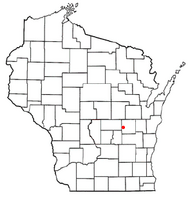Delhi, Wisconsin facts for kids
Delhi, Wisconsin, is a ghost town located in the town of Rushford, Winnebago County, Wisconsin. It sits where the Fox River meets Waukau Creek, between the towns of Omro and Eureka. This area was also known as La Borde's Landing. In 1890, census records called Delhi "Island Park." Delhi even had its own post office from 1850 to 1893.
Quick facts for kids
Delhi, Wisconsin
|
|
|---|---|
|
Ghost Town
|
|
| Nickname(s):
Island Park/LaBorde's Landing
|
|

Location of Delhi, Wisconsin
|
|
| Country | United States |
| State | Wisconsin |
| County | Winnebago |
| Elevation | 751 ft (229 m) |
| Time zone | UTC-6 (Central (CST)) |
| • Summer (DST) | UTC-5 (CDT) |
Contents
History of Delhi
Delhi was started by Luke La Borde, a French Canadian trader. He claimed the land, about 145 acres, on March 1, 1848. The town grew as more land was sold. A survey of the land was done on July 17, 1849.
Town Layout
The lots in Delhi were all the same size. Each lot was 66 feet wide and 132 feet deep. The main street, called Broadway, was wider at 82 and a half feet. All other streets were 66 feet wide. Streets like Water, Union, Washington, Liberty, Grand, Ann, Broad, Harrison, Howard, Pearl, Main, and Menominee are listed in an old Winnebago County book from 1889.
Native American History
The area where Delhi was built was once used by local Native American tribes as a burial ground. Early settlers sometimes found old pottery, beads, guns, copper, and other objects when they were plowing their fields in the spring. Many of these historical items are now kept at the Oshkosh Public Museum.
A Busy Trading Post
Delhi became a popular trading post for local Native Americans and settlers from nearby Eureka and Omro. Luke La Borde built a special "float bridge" to help people from Poygan, Winneconne, and Rushford get to the gristmills in Waukau. A gristmill is a place where grain is ground into flour.
Besides being a trading post, Delhi had many businesses:
- Three stores
- Two grain mills
- Three hop mills and a hop press
- A sawmill
People in Delhi also built boats and made furniture. The town had a livery, which was like a stable for horses and carriages. There was also a schoolhouse, a large 22-room hotel, and a bar. Hops, which are plants used to make beer, were grown and pressed in Delhi. Then, they were shipped to bigger cities like Oshkosh and Milwaukee.
Later, a dock was built, and steamboats regularly stopped in Delhi. A small stagecoach also traveled daily from Oshkosh to Omro, Eureka, and other places, bringing passengers and mail to Delhi.
Why Delhi Became a Ghost Town
Delhi slowly became empty and fell apart. The town once hoped to become the "county seat," which is the main town for government in a county, but it lost out to Omro and Eureka. Trade started to move away from Delhi when Omro and Eureka built better bridges. Also, a railroad line was built in Omro, which made it easier for goods and people to travel there instead of Delhi. Because of this, many of Delhi's residents moved to the neighboring villages and other places.
Today, only one old, rundown house from that time still stands. Luke La Borde and his wife, Louisa, are buried on the property where Delhi once thrived.

